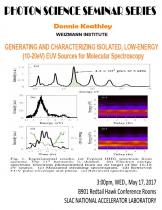Speaker: Donnie Keathley, Weizmann Institute
Program Description
The issue of generating low-energy (10-20 eV) EUV sources using high harmonic generation will be discussed. Acetone is explored as a low work function (9.69 eV), cost-effective target for generating low-energy (10-30 eV), extreme ultraviolet (EUV) sources ideal for time-resolved molecular spectroscopy. A flux of 4.4x10^9 ph/s at 3 kHz repetition rate was obtained in the 11th harmonic near 17 eV under tight-focusing conditions. The flux is comparable to high harmonic generation from Xe targets under similar conditions, making it a cost-effective alternative for high-flux HHG systems at MHz repetition rates. Issues surrounding the temporal characterization of such pulses will also be addressed. Attosecond streaking was used to demonstrate temporal coherence of the generated EUV pulses from acetone. As a concept demonstration, we used the harmonics generated from acetone to tailor a 2.66 fs pulse spanning 16-18 eV, ideal for selectively producing bound H2+ molecules to investigate vibrational states.
Bio: Donnie Keathley is currently a research scientist in the Ultrafast Optics and X-Rays group at MIT. He has worked in the areas of strong-field physics, high harmonic generation and ultrafast optics since 2009. His current research interest include novel photon and electron sources as well as lightwave driven electronics.





